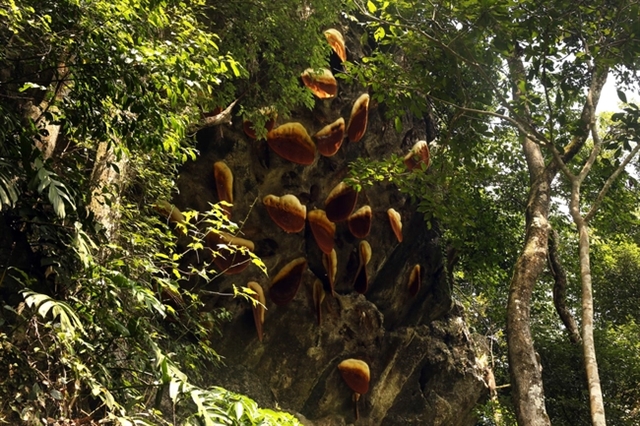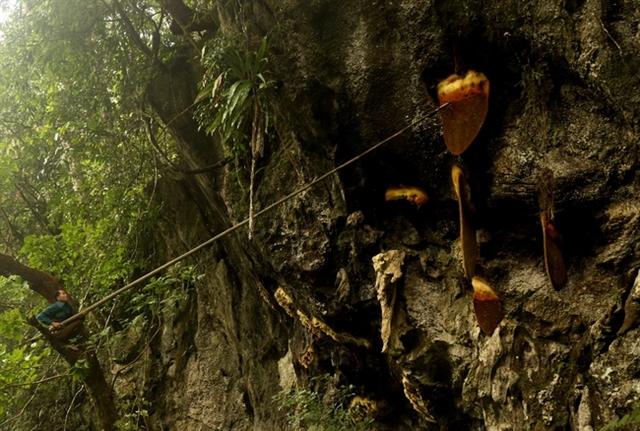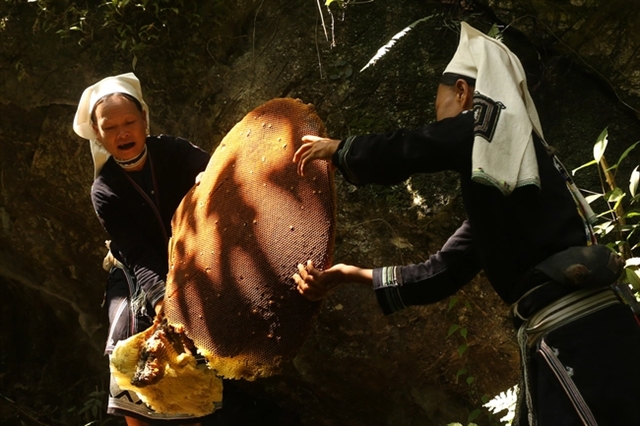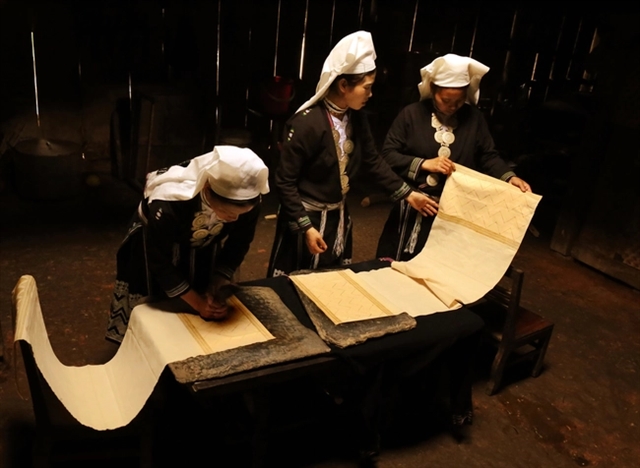Weather:
- Ha Noi 15oC
- Da Nang 19oC
- Ho Chi Minh 24oC
For more than 30 households in Hoài Khao Village, located in Quang Thành Commune, about 20km from Nguyên Bình Town and 60km from Cao Bằng City, harvesting beeswax is celebrated as a traditional yearly festival. After several visits to Hoài Khao Village and experiencing the journey up the slopes to the Khoái bee cave with the locals, artist Bằng Cao created a photo series titled Báu Vật Truyền Đời - Sáp Ong Rừng (A Timeless Treasure - Wild Beeswax), reflecting the traditional art of the ethnic Dao Tiền group in making beeswax batik print patterns for fabric and clothing.
The photo series made a strong impression on viewers and was honoured with the First Prize at the ninth 'Heritage Photography Awards - Heritage Journey' in 2023.
'A Timeless Treasure - Wild Beeswax'
The first time photographer Bằng Cao visited Hoài Khao was in 2020, when the area lacked electricity and mobile network coverage. At that time, he sought to escape the bustling, hectic daily life in the city and reconnect with nature.
He spent the next few years capturing moments in his photo series 'A Timeless Treasure - Wild Beeswax'. There were even times when it seemed impossible to complete the project due to the challenges posed by the COVID-19 pandemic in 2021.

"Before photographing the wild beeswax series, I had already captured the Dao Tiền people printing patterns on fabric with beeswax, so I had some understanding of their culture. As far as I know, harvesting wild beeswax only occurs once a year, and there is no fixed date for it, which means all my preparations were spontaneous and opportunistic," he said.
"I was fortunate to have made friends with some of the locals during my visits here. So when I received the news one afternoon that the villagers would begin harvesting wild beeswax the next day, I had to travel through the night to reach Hoài Khao in time," he said.

With no time to rest, Cao immediately navigated steep and treacherous mountain paths through the night to reach Hoài Khao, where he followed villagers into the forest to the Khoái bee cave for the harvest. Experiencing the grandeur of nature while witnessing villagers as they retrieved pieces of honeycomb from cliffs several dozen metres high -- and observing the meticulous process of boiling the honeycomb to create pure beeswax --the photographer confirmed that all the effort, fatigue, and hard work were worth it.

"It seems that my theme is something both unusual and rare, something few have explored before. Additionally, I have a feeling that I want to present to people unique images that will be difficult to capture again in the future," he said.
A traditional relationship with the Khoái bees
Since ancient times, the spiritual and cultural life of the Dao Tiền people has been closely linked to wild beeswax, or Khoái bees, as it is an essential material they use to create patterns on their traditional clothing.

Therefore, the locals hold a deep reverence for these bees. Each year, they conduct rituals to ensure that the Khoái bees return to their caves in the warmth of spring, bringing luck and blessings to the entire village, fostering peace, prosperity and happiness.
The locals harvest beeswax directly from two caves, Chán Vềnh and Tà Lạt, where the bees come to nest in the spring and leave in the autumn. The entire village must wait until all the bees have departed and there is no honey left in the hive before they begin preparing for the harvest. If they take the honey, the Khoái bees will not return, so the Dao Tiền people are reluctant to allow outsiders near the Khoái bee caves and take extensive measures to protect them.
The danger posed by these bees is another reason the locals always warn visitors whenever they come to Hoài Khao Village.

For over 30 households in Hoài Khao village, harvesting beeswax is regarded as a traditional yearly festival, and has become an integral part of the local ethnic identity.
In the village's warm and joyful atmosphere, the chief takes the lead in organising tasks. This includes coordinating logistical preparations that last two to three days, during which each household contributes food for communal activities at the cultural house. He also divides the villagers into groups to head into the mountains for the harvest and to transport the beeswax back for processing.
A native Hoài Khao villager, 45-year-old Lý Thị Hường said typically in the sixth lunar month, when the Khoái bees have all departed, a respected sorcerer is invited to choose an auspicious day for the ritual to honour the forest, mountain and bee spirits. These traditional ceremonies, rooted in ancient customs, express hopes for the deities' blessings for a successful harvest and for the bees to return to nest the following year. The ceremonies are conducted simultaneously from the moment the hives are tapped until the harvesting is complete.

After transporting the hives from the caves, the locals use three large pans, two for boiling and one to catch the melted beeswax.
In the first step, the harvested beeswax is placed into two pots of boiling water, where the pure wax gradually melts away from the comb, resembling oil slicks on the water's surface. Once the impurities from the raw beeswax are removed, the locals add cold water to the pots. The cold water causes the wax to crystallise, forming glistening golden layers on the surface. The pure beeswax is then skimmed off, squeezed by hand to remove excess water, and placed into sacks.
The final step is to concentrate the beeswax into a solid block. At this stage, the previously squeezed wax layers are washed again to remove any remaining impurities before being placed back into the pan for further boiling until they solidify. This process ensures the wax maintains the right softness and smoothness for printing on fabric, allowing it to adhere well and be stored for use over many years.

According to Hường, in years with a good harvest, each household can receive up to 2kg of pure beeswax, while in lean years, they might only get about 1kg.
"For experienced villagers, 1kg of beeswax can be used for seven to eight dresses, but for younger ones, it is typically used for only around five to six dresses," she said.
|
The entire village must wait until all the bees have departed and there is no honey left in the hive before beginning preparations for the beeswax harvest. If they take all the honey, the Khoái bees will not return. |
Cultural heritage lies in the hands of women
All Dao Tiền women in Hoài Khao Village are skilled in the technique of printing patterns with beeswax. Girls begin learning and practicing drawing with beeswax on their clothing as early as 10 years old, and usually by around 12 years old.

First, the white fabric is laid flat on a surface, such as a stone slab or table, and then smoothed and refined using a stone grinder. The pure beeswax, cut into small pieces for use, is placed in a bowl and heated over charcoal with a low flame to ensure the wax remains hot enough to adhere to the fabric and create clear patterns.
Depending on the predetermined patterns for the hem of the skirt, collar or sleeves, the women use various tools to dip into the beeswax and print the designs onto the fabric.
"These steps don't take much time; experienced women can complete a dress in just one day," Hường said.

After the beeswax has dried, the fabric is taken for indigo dyeing, which is the most labour-intensive and time-consuming step. Each complete outfit takes nearly a month to finish, as the fabric is dyed, dried, and then dyed again about 15 to 20 times. On sunny days, it can be dyed twice, but on cloudy days, it may only be dyed once. If it rains, and the fabric takes too long to dry, the artisans may have to wait until the following day to continue dyeing.
The dyed fabric is finally soaked in hot water to dissolve all the beeswax, revealing the distinct ivory patterns that emerge clearly against the indigo background.
The traditional outfits of Dao Tiền women resemble hand-crafted works of art, featuring intricate and vibrant patterns rich in aesthetic appeal, depicting elements like plants, flowers, waves and animals. Elaborate costumes are typically worn by Dao Tiền girls during festivals and weddings, and are also worn by sorcerers during ceremonial rites.
Tourism development and concerns about the future
After winning the First Prize at the ninth Heritage Photography Awards, Cao returned to the village of Hoài Khao, committed to preserving the valuable images of the community. He noticed significant changes in the area during his visit, reflecting both the impact of tourism and the evolving dynamics of village life.
Under the National Target Programme for Socio-Economic Development, Hoài Khao Village has been selected for investment in community tourism development to attract a large number of visitors.

As she introduced her traditional ethnic clothing, Lý Thị Hường said: "I am very pleased to have the opportunity to show the dress made by the hands of Dao Tiền women to everyone. I hope more and more tourists will come to our homeland, to Hoài Khao Village, to experience the cultural traditions of the Dao Tiền people."
The lives of the Dao Tiền people have indeed changed significantly compared to previous years. Dirt roads have been replaced with concrete, many homes have been transformed into homestays for tourists, and mobile phone network coverage and internet connectivity have improved rapidly. All of these developments are gradually enhancing the quality of life for the more than 30 households in the village, alleviating their previous hardships.
However, alongside the influences of modern society, more traditional aspects tied to nature are often less sustainable.
"On this return visit, I noticed that the number of bee hives in the caves is fewer than in my previous two visits, and the quantity of beeswax has also decreased; it’s no longer the same as before," Cao said.
Wild beeswax has long been one of nature's 'gifts,' regarded as a 'timeless treasure' for humanity. However, if not carefully preserved and protected, it may one day disappear. Nothing lasts forever, especially as the rapid development of modern society causes traditional practices to gradually fade away.
|
A brief overview of Khoái Bees or giant honey bees Khoái bees, scientifically known as Apis dorsata, are also called giant honey bees. With lengths reaching 17-20mm, they typically build open nests hanging from large tree branches or cliff faces, and sometimes even on buildings. Each Khoái bee hive can contain up to 100,000 bees, with nests often located just a few centimetres apart. This species is renowned for its aggressive nature, described as one of the most dangerous animals in the Southeast Asian rainforest due to their fierce defensive behaviour, even more than that of African honey bees. |


